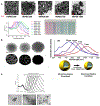Applications of Gold Nanoparticles in Plasmonic and Nanophotonic Biosensing
- PMID: 38273208
- PMCID: PMC11182655
- DOI: 10.1007/10_2023_237
Applications of Gold Nanoparticles in Plasmonic and Nanophotonic Biosensing
Abstract
The unique properties of plasmonic nanoparticles and nanostructures have enabled a broad range of applications in a diverse set of fields, ranging from biological sensing, cancer therapy, to catalysis. They have been some of the most studied nanomaterials due in part to their chemical stability and biocompatibility as well as supporting theoretical efforts. The synthesis and fabrication of plasmonic nanoparticles and nanostructures have now reached high precision and sophistication. We review here their fundamental optical properties, discuss their tailoring for biological environments, and then detail examples on how they have been used to innovate in the biological and biomedical fields.
Keywords: Gold nanoparticles; Photothermal; Plasmon-enhanced fluorescence; Plasmonics; Surface plasmon resonance; Surface-enhanced Raman spectroscopy.
© 2023. The Author(s), under exclusive license to Springer Nature Switzerland AG.
Figures











Similar articles
-
Noble metals on the nanoscale: optical and photothermal properties and some applications in imaging, sensing, biology, and medicine.Acc Chem Res. 2008 Dec;41(12):1578-86. doi: 10.1021/ar7002804. Acc Chem Res. 2008. PMID: 18447366
-
Plasmonic gold nanostructures for biosensing and bioimaging.Mikrochim Acta. 2021 Aug 25;188(9):304. doi: 10.1007/s00604-021-04964-1. Mikrochim Acta. 2021. PMID: 34435258 Free PMC article. Review.
-
DNA-tailored plasmonic nanoparticles for biosensing applications.Wiley Interdiscip Rev Nanomed Nanobiotechnol. 2013 Jan-Feb;5(1):96-109. doi: 10.1002/wnan.1196. Epub 2012 Aug 27. Wiley Interdiscip Rev Nanomed Nanobiotechnol. 2013. PMID: 22927287 Review.
-
Approach for plasmonic based DNA sensing: amplification of the wavelength shift and simultaneous detection of the plasmon modes of gold nanostructures.Anal Chem. 2013 Mar 19;85(6):3288-96. doi: 10.1021/ac3036316. Epub 2013 Mar 1. Anal Chem. 2013. PMID: 23413826
-
Polarized and Evanescent Guided Wave Surface-Enhanced Raman Spectroscopy of Ligand Interactions on a Plasmonic Nanoparticle Optical Chemical Bench.Biosensors (Basel). 2024 Aug 23;14(9):409. doi: 10.3390/bios14090409. Biosensors (Basel). 2024. PMID: 39329784 Free PMC article.
Cited by
-
Investigations on Thermal Transitions in PDPP4T/PCPDTBT/AuNPs Composite Films Using Variable Temperature Ellipsometry.Polymers (Basel). 2025 Mar 6;17(5):704. doi: 10.3390/polym17050704. Polymers (Basel). 2025. PMID: 40076196 Free PMC article.
References
-
- Link S, Mohamed MB, El-Sayed MA, Simulation of the Optical Absorption Spectra of Gold Nanorods as a Function of Their Aspect Ratio and the Effect of the Medium Dielectric Constant, The Journal of Physical Chemistry B 103(16) (1999) 3073–3077.
-
- Mie G, Articles on the optical characteristics of turbid tubes, especially colloidal metal solutions, Ann. Phys 25(3) (1908) 377–445.
-
- Link S, El-Sayed MA, Optical Properties and Ultrafast Dynamics of Metallic Nanocrystals, Annual Review of Physical Chemistry 54(1) (2003) 331–366. - PubMed
-
- Brust M, Walker M, Bethell D, Schiffrin DJ, Whyman R, Synthesis of thiol-derivatised gold nanoparticles in a two-phase Liquid–Liquid system, Journal of the Chemical Society, Chemical Communications (7) (1994) 801–802.
Publication types
MeSH terms
Substances
Grants and funding
LinkOut - more resources
Full Text Sources

